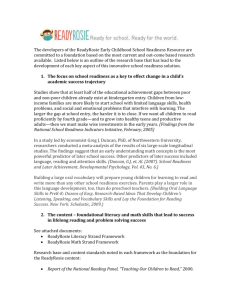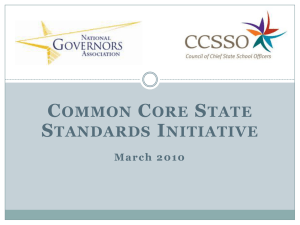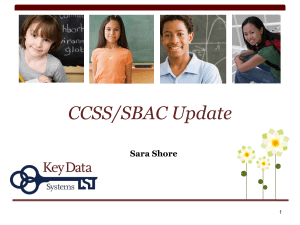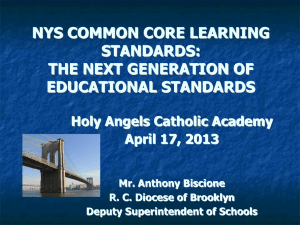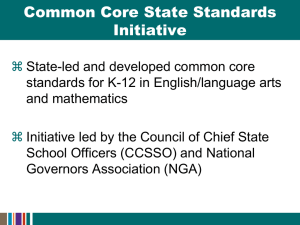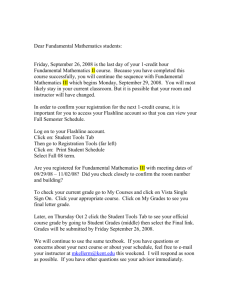A First Look at Student Performance on the Common Core
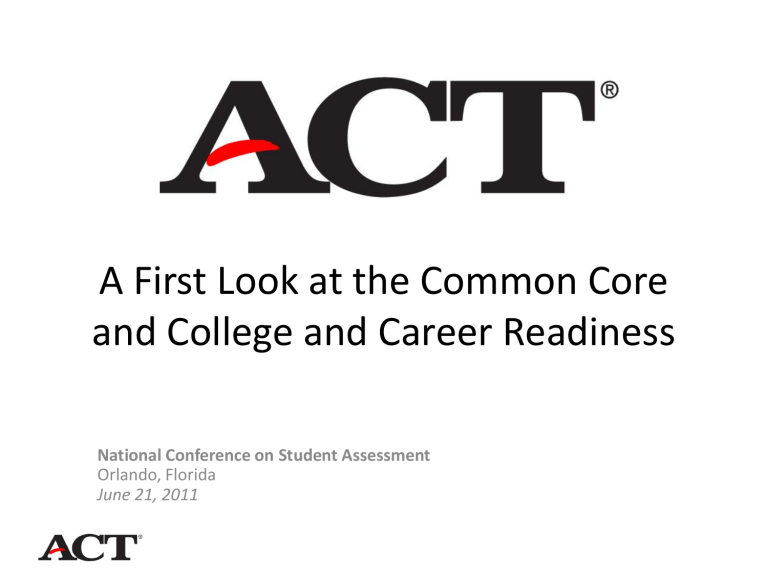
A First Look at the Common Core and College and Career Readiness
National Conference on Student Assessment
Orlando, Florida
June 21, 2011
Readiness – the Great Equalizer
Ensuring kids are prepared for college by the time they leave high school is the single most important thing we can do to improve college-completion rates.
• Mind The Gaps (ACT, 2010) http://www.act.org/research/policymakers/pdf/MindTheGaps.pdf
A First Look at the Common Core
A Unique Opportunity
Deep Understanding of College and Career Readiness and the Common Core
• One of three development partners in the Common Core
• Research-based College Readiness Indicators
• ACT definition of College and Career Readiness the same as that of the Common Core State Standards Initiative
• Aligned ACT solutions (e.g., ACT, PLAN, EXPLORE) to the Common
Core
( http://www.act.org/commoncore/pdf/CommonCoreAlignment.pdf
)
• Large national sample of students who take the ACT as part of their statewide assessment program – not self selected
A Unique Opportunity
Large Sample of students taking the ACT:
• 250,000+
• Not self-selected
• Multiple states
• Full range of abilities and college aspirations
• Rural, suburban, and urban schools
• Standard and accommodated test takers
• 67% Caucasian, 17% African-American, 11% Hispanic, 6% Other
• Typical 11 th grade students like you’d find in high schools across the country
A Unique Opportunity
No performance standards related to the Common
Core.
Coded items from the ACT test to the domains and clusters of the
Common Core
Analyzed performance of college ready students to determine a proxy performance level for each strand and cluster of the
Common Core
Looked at performance of college ready students in each of the domains and clusters of the
Common Core
Common Core ‘Proficiency’
Findings
Louisville, KY November 2010
A First Look at Common Core ELA
Range of Reading - Text Complexity
25
20
15
10
5
0
40
35
30
31
29
38
All 11th Grad Caucasian
11
African
American
18
Hispanic
Hispanic
African American
Caucasian
All
• Too few students (31%) are able to work with complex text
– Students need exposure to a wide variety of text
– Students need to focus on reading progressively more complex texts as they advance through the early and middle grades
A First Look at Common Core ELA
Knowledge of Language and
Vocabulary Acquisition
50
40
30
20
10
0
35
39
43
All 11th Grad Caucasian
17
African
American
14
Hispanic
Hispanic
African American
Caucasian
All
• Increased focus is needed on language and vocabulary acquisition
– Focus on Language Standard 3 (which begins formally in grade 2) and focuses on recognizing the differences between formal and informal
English
– Students would benefit from direct vocabulary instruction with emphasis on acquiring vocabulary through reading beginning in grades
4-5
Louisville, KY November 2010
A First Look at Common Core Math
Number and Quantity
30
25
20
15
10
5
0
45
40
35
34
30
42
10
16
Hispanic
African American
Caucasian
All
All 11th Grad Caucasian African
American
Hispanic
• Increased focus is needed on the foundations of mathematics
– Low performance on N&Q is particularly concerning – foundational for success in other more complex CCSS categories such as Algebra,
Geometry, and Functions
– Focus on N&Q from the earliest grades and build on those foundations
• Early grade hands on experiences with numbers and measurement
• Middle and high school connections between Number and Quantity and other CCSS mathematical concepts – particularly Algebra
A First Look at Common Core Math
Math interventions are needed for struggling students at the earliest grades
•
Monitor and identify struggling students as early as possible (K-4)
• Early diagnostic & formative assessment of CCSS math domains at the earliest grades are necessary
A First Look at Common Core Math
Mathematical Practices
1.
Make sense of problems and persevere in solving them
2.
Reason abstractly and quantitatively
3.
Construct viable arguments and critique the reasoning of others’
4.
Model with mathematics
5.
Use appropriate tools strategically
6.
Attend to precision
7.
Look for and make use of structure
8.
Look for and express regularity in repeated reasoning
• Greater understanding of mathematical processes and practices is needed
– Working to solve challenging non-routine math problems
– Explaining methods and justifying conclusions
– Predicting and conjecturing about things such as unknown numbers, probability of events, and quantitative relations
– Looking for patterns in structure and diagrams, number systems, tables, graphs, etc.
Managing the Change
• Shifting Expectations – Not a Drop in Student Achievement
• Challenging but Achievable
Shift in Expectations
Not a Drop in Student Achievement
80
70
60
50
40
30
20
10
0
STATE ‘A’ - Percent of ACT-tested Students Meeting
College Readiness Benchmarks, by Subject and Year
71 72
56 57
60
46
45 45
36
89,000
64
48
40
145,000
English
Reading
Mathematics
2002 – first year implementation of statewide ACT assessment of all students
80
70
60
50
40
30
20
10
0
STATE ‘B’ - Percent of ACT-tested Students Meeting
College Readiness Benchmarks, by Subject and Year
72 72
58 57
42 42
61
49
34
62
51
39 English
Reading
Mathematics
27,000 52,000
Challenging – But Achievable
80
70
60
50
40
30
20
10
0
District ‘A’ - Percent of ACT-tested Students Meeting
College Readiness Benchmarks, by Subject and Year
76
59
53
70
54
63
47 49
39
49
42
36
English
Reading
Mathematics
80
70
60
50
40
30
20
10
0
District ‘B’ - Percent of ACT-tested Students Meeting
College Readiness Benchmarks, by Subject and Year
74 74 76
61 62
67
57
63
63
53
56
51
English
Reading
Mathematics
Alabama Example Schools
Red Bay HS - Trend
Alabama Example Schools
Hillcrest HS - Growth
Potential Long-term Success
College and Career
Readiness in Mathematics
College and Career
Readiness Standards
Increased readiness of students meeting College and Career Benchmark
Current U.S. Performance
Shanghai-China
Singapore
Hong Kong-China
Korea
Chinese Taipei
Finland
Liechtenstein
Switzerland
Japan
Canada
Netherlands
Macao-China
New Zealand
Belgium
Australia
Germany
Estonia
Iceland
Denmark
Slovenia
Norway
France
Slovak Republic
Austria
OECD average
Poland
Sweden
Czech Republic
United Kingdom
Hungary
Luxembourg
United States
Ireland
Portugal
Spain
Italy
Latvia
Lithuania
Russian
Greece
Croatia
Dubai (UAE)
Israel
Turkey
Serbia
Azerbaijan
Bulgaria
Romania
Uruguay
Chile
Thailand
Mexico
Trinidad and
Kazakhstan
Montenegro
Argentina
Jordan
Brazil
Colombia
Albania
Tunisia
Indonesia
Qatar
Peru
Panama
Kyrgyzstan
0 100 200 300
381
377
371
371
368
365
360
331
419
419
414
405
403
388
387
386
447
445
442
431
428
427
427
421
483
483
482
477
468
466
460
453
496
495
494
493
492
490
489
487
487
487
512
507
503
501
498
497
497
496
529
527
526
525
519
515
514
513
536
534
530
562
600
555
546
543
541
Significantly above the
College & Career Readiness
Benchmark
US College & Career Readiness Benchmark
Significantly below the
College & Career Readiness
Benchmark
Not significantly different from the OECD average
Significantly above or below the OECD average
400 500 600 700
Average PISA 2009 Mathematics Score
800 900 1000
Internationally Competitive
Estimated U.S. rank on
PISA if students all students were college and career ready 7 th
Source: ACT, Affirming the Goal
Economic Impact
Estimated annual increase to U.S. GDP if
U.S. academic achievement rose as expected by meeting a college and career threshold
$507B
Source: OECD
Focus on Implementation
• A Sense of Urgency
– Use the next four years to create, deploy, and align instructional strategies, interventions, and diagnostic tools to best support teaching and learning of the Common Core
• New Standards – New Opportunities
– Begin thinking about new forms of accountability to include student growth toward college and career ready standards
– Leverage ESEA Reauthorization
• Ensure federal programs support College and Career Readiness
• Empower local districts to better focus resources and strengthen professional development of teachers to support learning of the Common Core
• Transition to College and Career Ready Standards
– Initial results are due to shifting expectations not a drop in student achievement
– Moving to higher standards will be challenging for our education systems – but it is achievable
Summary of Recommendations
Instructional Impact Areas
• Text Complexity
States and districts should ensure that students are reading progressively more complex texts at all grade levels but especially in middle grades and high school to ensure they are working at levels that allow them to read college and career level material independently and proficiently by the time they graduate.
• Language and Vocabulary Acquisition
States and districts can begin overcoming this challenge by focusing on the differences between formal and informal language as early as the second grade and building a command of language from the earliest grades through high school.
• Number and Quantity
To increase overall math performance states and districts should ensure that students in the early grades are working with hands on math experiences and solving unique and novel problems.
Additionally, middle and high school students should be making connections between numbers and quantity and the more complex categories, particularly Algebra.
• Mathematical Practices
To ensure students have the appropriate conceptual understanding of math principles, ACT recommends states and districts ensure that students at all levels are explain methods and justifying conclusions; predicting outcomes and conjecturing about unknown numbers and measurements; and looking for patterns and structure in a variety of mathematical settings.
For more information, contact:
Scott Montgomery, Assistant Vice President,
Strategic Initiatives scott.montgomery@act.org
or 319-337-1465
Alabama’s Road Map for Implementation of
College and Career Ready Standards
National Conference on Student Assessment
Orlando, FL
June 21, 2011
Instructional Services
Mission Statement
• To provide the standards, resources, and support local education agencies need to ensure all students graduate college and/or career ready
Establishing College and Career
Ready Expectations
• Adoption of First Choice
– May 8, 2008
• Adoption of New Assessment System
– September 10, 2009
• Adoption of College and Career Ready Standards based on Common Core State Standards
– November 18, 2010
Road Map for Implementation
• Engage Public Stakeholders
• Develop Quality Professional
Development
• Align Data Systems with College and
Career Ready Efforts
• Identify and Monitor Indicators of
Progres s
Engage Public Stakeholders
• Prior to adoption of standards
– Development of College and Career
Ready Standards included 7 noneducators
– 4 town hall meetings
– Draft of standards posted on SDE website for public review
– Public hearing
Engage Public Stakeholders
• After adoption of standards
– Presentations at professional conferences throughout state
– Publications
– Information included on Department’s website
( www.alsde.edu
)
– Expecting Excellence brochure
– Involvement of the 11 college and university in-service centers across the state
– Inclusion of education association and leadership association in Implementing the Common Core
Standards SCASS team membership
Public Resource
s
• Alabama Virtual Library
– Provides all students, teachers, and citizens of the State of
Alabama with free online access to essential library and information resource including courses of study with lesson plans
– Includes Britannica Online and other resources
• ALEX
– Designed to index and share educational materials and information through a time-saving, one-stop resource for educators, parents, and students
– Majority of resources (lesson plans, Web links, and interactive activities) are connected to Alabama’s college and career ready standards
• SDE website
Develop Quality
Professional Development
• Includes cross-sectional SDE staff in development and implementation
– Alabama Reading Initiative
– Alabama Math, Science, and Technology Initiative
– Assessment and Accountability
– Curriculum and Instruction
– Federal Programs
– Special Education Services
– Technology Initiatives
• Includes feedback from university partners
Timeline for Implementation
November 2010—May 2011
◦ State Professional Development and Resource Development
◦ State Collaboration with Participating States
June 2011—July 2012
◦ Phases of Mathematics and ELA Professional Development for Teachers and Administrators Begin
(Inservice Centers & MEGA)
◦ Alignment of Local Curricula to State Mathematics Standards
Spring 2012
◦ Local Mathematics Textbooks/Resources Adoption
School Year 2012—2013
◦ Implementation of Mathematics Course of Study
◦ Phases of ELA Professional Development for Teachers and Administrators Continue
◦ Alignment of Local Curricula to State ELA Standards
Spring 2013
◦ Local ELA Textbooks/Resources Adoption
School Year 2013—2014
◦ Implementation of ELA Course of Study
School Year 2014—2015
◦ Administer new assessments based on new standards
2010 Alabama Course of Study: Mathematics
Professional Development Timeline
Phase I Phase II Phase III
Components of the Course of Study
High School Course Progressions/Pathways
Analyzing the Standards
Building Capacity of Teachers
Standards for Mathematical Practices
Literacy Standards for Grades 6-12
Differentiated Instruction for RtI
Resources
Domains of Study and Conceptual Categories Formative Assessments
Learning Progressions/Trajectories Other States
Addressing Content Shifts Organizations
Early Entry Algebra I Sample Units of Study
Continuous Support
2010 Alabama Course of Study: English Language Arts
Professional Development Timeline
Phase I Phase II Phase III
Components of the Course of Study, including Appendices
Analyzing the Standards
Sample Units of Study
Continuous Support
Strands (Comparison, New Emphases) Sample Lessons/Curriculum Development
Vertical Alignment/Learning Progressions Differentiated Instruction for RtI
Content Movement
Literacy Standards, Grades 6-12
Resources
Timeline for PD and Implementation
Assessment
Implications for Special Education
Align Data Systems with
College and Career Ready Efforts
• Ensure data system supports longitudinal, comprehensive tracking of college and career readiness
– INOW allows standards-based and skills-based reporting (report cards)
– INFOCUS allows data mining and creation of dashboards
– Data warehouse allows data mining
• Address issues of moving from current accountability system to new standards
– Discussions with congressional delegation
– Discussions with State Board of Education
– Discussions with local superintendents
Identify and Monitor
Indicators of Progress
• Includes monitoring during transition
– Implementation of EPAS
• EXPLORE
• PLAN
• ACT with Writing
– Implementation of WorkKeys
– Establishment of college and career readiness targets for reading and mathematics in grades 3-7 based on
EXPLORE results
• Study and emulate implementation by higher performing schools/districts
Implementation of College and
Career Ready Standards Means …
To a Student
◦ A K–12 articulated learning progression based on college and career readiness
To Parents
◦ Assurance that their children will be prepared for success in college and their chosen careers
To a Teacher/Administrator
◦ Provision of a clear, explicit, and rigorous guide to move students along their learning progression
To Higher Educati on
◦ An opportunity to develop a more clearly articulated relationship with K-12
To Business and Industry
◦ Assurance that an Alabama high school graduate is prepared for college and career opportunities

